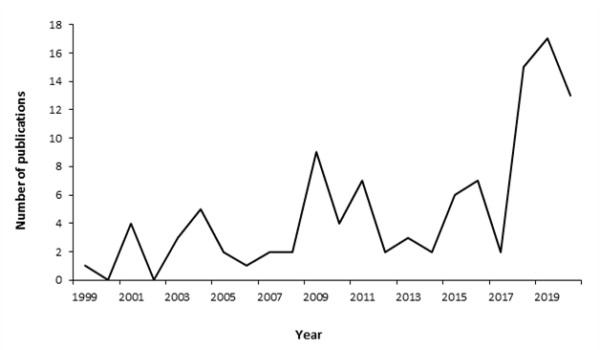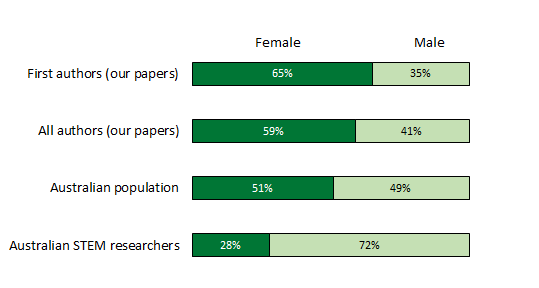Research Impact
In 23 years, scientists conducting research at Arid Recovery have produced 107 scientific publications.
We’re really punching above our weight for a small non-profit, and smashing through the glass ceiling for women in STEM (science, technology, engineering, and mathematics). Most importantly, our research is being applied all around Australia – and beyond – for better conservation.
We’ve researched our research. Crunched the numbers, graphed the stats, and tried to measure the impact Arid Recovery has made on Australian conservation and ecology. Here’s what we’ve found…
So far, 107 peer-reviewed papers have been produced from Arid Recovery research – a huge number for a small NGO! You can see the full publication list here. That’s an average of 5 papers per year, increasing over time as long-term projects come to fruition.

Our long-term projects have been many and varied, tackling major themes of:
-
How to reintroduce native animals
-
How these reintroduced animals affect the ecosystem
-
How to improve control methods for feral predators
-
How to smarten-up native animals, so that they improve their response to feral predators
-
Whether our most vulnerable animals can be released outside fences
These are questions that will keep us busy for many years to come. But with 107 papers already out, we understand a lot more than we used to. And this high output is thanks to two things: reserve design and collaboration.
The reserve design is crucial; six large ‘exclosures’, each of which can be manipulated to suit research at a landscape scale. This allows us to keep effective control areas, and directly study the before-and-after impacts of management decisions and reintroductions.
As for collaboration – Arid Recovery has published alongside 76 other organisations, including governments, universities and industry. Tapping into such a vast array of knowledge, experience and ideas has made our research much richer as a result. One-third of our research has been led by our staff, with the remainder all first-authored by external collaborators.
From these collaborations, we’ve had over 300 co-authors on our papers. Of these, one thing stands out, our female scientists are leading the charge.

65% of our papers have been first-authored by women, and 59% of all authors have been women. This is a stark improvement on the national average, where only 28% of STEM academic/research staff are women. One of Arid Recovery’s most prolific authors is co-founder and Principal Scientist Dr Katherine Moseby who has collaborated widely and supported many of our research students.

Most importantly, we want to produce research of a high quality. How do we judge this? It’s difficult, but we can try in a few ways:
-
Impact factor: ‘Impact factors’ judge journals based on how many citations they get. The average impact factor of journals Arid Recovery has published in is 2.7, while the average of all journals is less than 1. This is a good sign for us, because with impact factors, bigger is better. Our highest impact factor journal has been Biological Conservation (10.7).
-
SCImago Journal Rank: SCImago tries to rank journal ‘prestige’. 98% of our papers have been in journals of the two highest-ranks – Q1 & Q2. Again, this indicates that Arid Recovery is consistently publishing in high-quality journals.
-
Tracking citations: We can track the number of times our papers are cited in other research – which is rising exponentially! You would expect citation counts to increase over time, as more research is produced and available for longer, but for them to rise exponentially year-on-year shows that the relevance and application of Arid Recovery’s research is snowballing.

Moseby, K. E., Read, J. L., Paton, D. C., Copley, P., Hill, B. M., & Crisp, H. A. (2011). Predation determines the outcome of 10 reintroduction attempts in arid South Australia. Biological Conservation, 144(12), 2863-2872.
Read, J., & Bowen, Z. (2001). Population dynamics, diet and aspects of the biology of feral cats and foxes in arid South Australia. Wildlife Research, 28(2), 195-203.
Moseby, K. E., Neilly, H., Read, J. L., & Crisp, H. A. (2012). Interactions between a top order predator and exotic mesopredators in the Australian rangelands. International Journal of Ecology, 2012.
Moseby, K. E., & Read, J. L. (2006). The efficacy of feral cat, fox and rabbit exclusion fence designs for threatened species protection. Biological Conservation, 127(4), 429-437.
James, A. I., & Eldridge, D. J. (2007). Reintroduction of fossorial native mammals and potential impacts on ecosystem processes in an Australian desert landscape. Biological Conservation, 138(3-4), 351-359.
And journals aren’t the only way to share research – there’s many other avenues like news, blogs, and social media. We can judge their online spread using Altmetrics. An Altmetric score over 20 indicates that your research is getting more attention than most. Arid Recovery’s average Altmetric score is 24, the average of our top-10 papers is 102, and our highest ever is 167. This is great news, and shows that our research is of interest outside of purely scientific circles.
Arid Recovery has become a significant research entity in Australian ecology. The research published so far has been targeted towards many pressing conservation challenges, and we now know far more about them than we did 20 years ago. Much of this research has been big and bold – from painstakingly eradicating rabbits, to mixing dingoes with cats and foxes, to placing feral cats back INTO paddocks with bettongs and bilbies, our focus has been to constantly push the science forward, backed up by rigorous attention-to-detail and long-term monitoring.